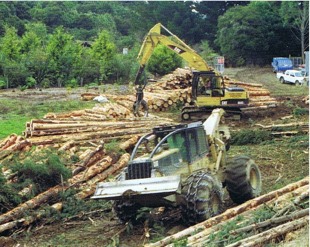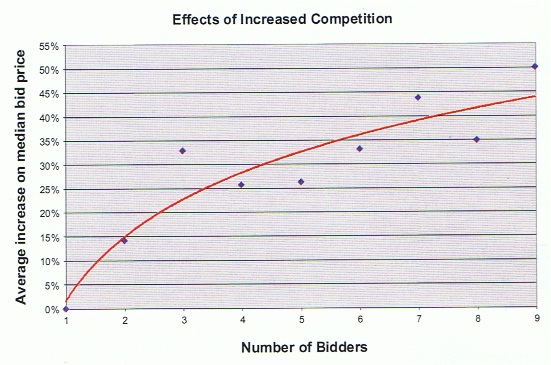Helping farmers sell wood
Peter Harington, New Zealand Tree Grower August 2005.
So what is it about Woodmetrics that aligns us so closely with the farm forestry sector?
Established in 2000 as a business unit of Carter Holt Harvey, Woodmetrics offers a unique service to small and medium size forest owners for maximising returns from their forestry investment. Woodmetrics was sold by CHH in a management buy-out in December 2003 and is now a truly independently owned and operated business with no obligations or commitments to any one player in the forestry industry.
Competitive tender selling
As a company that is completely independent of conflicting interests, we sell most of our client’s trees through a competitive tender process known as stumpage selling. This system ensures that maximum value is returned to the forest owner through promotion of genuine competition and by providing buyers with better pre-sale information to reduce price discounting. Stumpage selling requires a lot of work to prepare each block for market including accurate stand mapping, harvest planning and an intensive MARVL pre-harvest inventory that provides the basis for the sale. The secret is that the buyers have to trust the data that they are being presented with to bid to the hilt and without risk.
 This is different from how the industry has operated in the past. Traditionally wood has transferred into the market by the graded sale method. This involved choosing a log trader, or agent, and taking your chances with that organisation’s performance. The problem with this sale method is that the seller does not know how it went until after the job is over. The Woodmetrics process involves calculating a reserve price so the sale only proceeds if the owner’s expectations are met.
This is different from how the industry has operated in the past. Traditionally wood has transferred into the market by the graded sale method. This involved choosing a log trader, or agent, and taking your chances with that organisation’s performance. The problem with this sale method is that the seller does not know how it went until after the job is over. The Woodmetrics process involves calculating a reserve price so the sale only proceeds if the owner’s expectations are met.
The benefits of marketing to more than one buyer are the same for trees as for any other product. More buyers mean more competition and different buyers value the same forest differently resulting in different bid prices. One buyer will only provide one price.
Stumpage selling not for everyone
Not all blocks are suitable for stumpage selling. If the area is too small, less than two to four hectares, or too hard to accurately quantify so that bidders can bid with confidence, then a graded log sale may be the most appropriate sale method. Stumpage selling works particularly well in a buoyant timber market, where there is strong demand for specific log grades, or where a sawmill or harvesting crew is looking to secure supply.
No log buyer has access to all domestic and export markets. The question is, which buyer has access to the most valuable mix of markets at the time, or has the greatest need for the wood. The industry norm of selling to only one buyer removes the opportunity for significant gains in value that are obtained through selling to different markets and through greater bidder competition. Selling to one buyer limits the value of the forest to the value that the buyer can extract from their particular market mix.
Competition helps
Buyer differences in harvesting and cartage costs can easily account for a 10% variation in bid prices. If logs are being exported, different buyers will have different shipping rates, different exchange rate levels and other factors that can account for another 10%. As a seller, forest owners will not get exposure to these differences unless they sell their trees through a competitive tender process.
Independent research of private forest and woodlot sales has shown that the addition of a second bidder competing for a stumpage sale will, on average, increase returns to the forest owner by 15%. We have found this to be the case in stumpage selling over the last four years as demonstrated in the chart below.
 It is a totally transparent and fair process. Bids are lodged in a sealed envelope and the highest bid wins the tender. There are no back room secret handshake deals, the biggest number in the envelope wins and for total transparency both the seller and the bidders are invited to the bid opening.
It is a totally transparent and fair process. Bids are lodged in a sealed envelope and the highest bid wins the tender. There are no back room secret handshake deals, the biggest number in the envelope wins and for total transparency both the seller and the bidders are invited to the bid opening.
Risk aversion
Most Woodmetrics sales are sold on a composite price basis where bidders bid one price per tonne for every tonne produced. Every log, be it pruned or pulp, earns the owner the same. Forest owners do not have their income impacted by decisions or mistakes they have no control over, or even knowledge of.
Risk is a big consideration for sellers of wood, so Woodmetrics offer risk aversion as one of their key offerings. Each sale has a receivables protection insurance policy which protects clients in the unfortunate situation of a buyer not paying. On the one occasion when a buyer did go under on us, our insurance policy was appreciated by the forest owner. Other risk areas surrounding health and safety and environmental management are also covered.
What other way was there?
Our team tell the story of talking to an American logger at the Mystery Creek Fieldays this year. Having explained their process to him he asked them what other way was there to sell timber. When the team explained the traded log system traditionally used in New Zealand he just laughed ‘You mean they sell their wood and don’t even know what they are going to get for it?’ Although the US market is slightly different from New Zealand, stumpage selling is the traditional method used in the US to sell timber in volumes considerably greater than the total New Zealand cut.
All of the Woodmetrics team are active members of the NZFFA, attending many and even hosting farm forestry field days. With all the mergers and consolidation, and upheaval taking place in the industry, our small firm is devoted to assisting small forest owners still going strong.
The new owners are Philip Elworthy, Peter Harington and Ian Bell who each work independently in our own regions – Philip in Northland, Peter in Central North Island and Ian in the Southern North Island. Each have different backgrounds and skills so have the advantage of being able to work as a team for our clients but live in regions providing immediate contact.
Peter Harrington is one of the owners of Woodmetrics.

 Farm Forestry New Zealand
Farm Forestry New Zealand